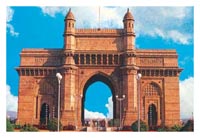 Begin with the Gateway of India, the city’s most famous landmark – an Indo-Saracenic archway built in 1911 to commemorate the visit of King George V and Queen Mary. It was originally conceived as an entry point for passengers arriving on P&O steamers from England; today it is remembered more often as the place from which the British staged their final departure. You will make a stop here for photographs. Begin with the Gateway of India, the city’s most famous landmark – an Indo-Saracenic archway built in 1911 to commemorate the visit of King George V and Queen Mary. It was originally conceived as an entry point for passengers arriving on P&O steamers from England; today it is remembered more often as the place from which the British staged their final departure. You will make a stop here for photographs.
The Prince of Wales Museum is the finest work done by architect George Wittet, who also designed the Gateway of India. It houses interesting displays of jade work, weapons from the Mughal Empire that belonged to Shah Jehan, Aurangzeb and Akbar, and clay and terracotta figures from the 3rd century BC.
Travel along Marine Drive, Mumbai’s seaside promenade, an eight-lane highway with a wide pavement. Its graceful curve sweeps from the skyscrapers at Nariman Point to the foot of Malabar Hill. The whole stretch is popular for strolling, and it is a great place for people watching. At the northern end is the lively Chowpatty Beach, a Mumbai institution.
Mani Bhavan was Gandhi’s Bombay base between 1917 and 1934. It is now a permanent museum and memorial to the Mahatma, and contains a research library of more than 20,000 volumes. A series of tiny dioramas tell his life story in an interesting fashion.
Even if you are not possessed of an interest in other people’s dirty laundry, you’ll be fascinated by the dhobi ghats. Each morning washing from all over Mumbai is brought here to be soaped, soaked, boiled, beaten, and thrashed. The next day, after being aired, pressed, folded and wrapped, the bundles are returned from whence they came. Stop here for photos that you’ll never be able to duplicate anywhere else.
On your way to the pier, you will drive past a most remarkable railway station. Inspired by St. Pancras Station in London, the Victoria Terminus was built during Queen Victoria’s Golden Jubilee year. The first train in India left from this station in 1853; today half a million commuters use the station every day.
 |